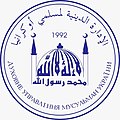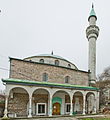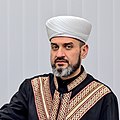
The Tatars, formerly also spelt Tartars, is an umbrella term for different Turkic ethnic groups bearing the name "Tatar" across Eastern Europe and Asia. Initially, the ethnonym Tatar possibly referred to the Tatar confederation. That confederation was eventually incorporated into the Mongol Empire when Genghis Khan unified the various steppe tribes. Historically, the term Tatars was applied to anyone originating from the vast Northern and Central Asian landmass then known as Tartary, a term which was also conflated with the Mongol Empire itself. More recently, however, the term has come to refer more narrowly to related ethnic groups who refer to themselves as Tatars or who speak languages that are commonly referred to as Tatar.
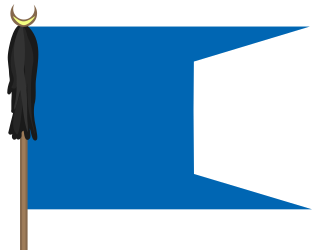
The Khanate of Kazan was a medieval Tatar Turkic state that occupied the territory of the former Volga Bulgaria between 1438 and 1552. The khanate covered contemporary Tatarstan, Mari El, Chuvashia, Mordovia, and parts of Udmurtia and Bashkortostan; its capital was the city of Kazan. It was one of the successor states of the Golden Horde, and it came to an end when it was conquered by the Tsardom of Russia.

Crimean Tatars or Crimeans are a Turkic ethnic group and nation native to Crimea. The formation and ethnogenesis of Crimean Tatars occurred during the 13th–17th centuries, uniting Cumans, who appeared in Crimea in the 10th century, with other peoples who had inhabited Crimea since ancient times and gradually underwent Tatarization, including Ukrainian Greeks, Italians, Goths, Sarmatians and many others. Despite the popular misconception, Crimean Tatars are not a diaspora of or subgroup of the Tatars.

The Crimean Khanate self-defined as the Throne of Crimea and Desht-i Kipchak and in old European historiography and geography known as Little Tartary, was a Crimean Tatar state existing from 1441–1783, the longest-lived of the Turkic khanates that succeeded the empire of the Golden Horde. Established by Hacı I Giray in 1441, it was regarded as the direct heir to the Golden Horde and to Desht-i-Kipchak.

The Lipka Tatars are a Turkic ethnic group who originally settled in the Grand Duchy of Lithuania at the beginning of the 14th century.

Islam is a major religious minority in the Russian Federation, which has the largest Muslim population in Europe. According to the US Department of State in 2017, Muslims in Russia numbered 14 million or roughly 10% of the total population. One of the Grand Muftis of Russia, sheikh Rawil Gaynetdin, estimated the Muslim population of Russia at 25 million in 2018.
The Crimean Tatar diaspora dates back to the annexation of Crimea by Russia in 1783, after which Crimean Tatars emigrated in a series of waves spanning the period from 1783 to 1917. The diaspora was largely the result of the destruction of their social and economic life as a consequence of integration into the Russian Empire.

Yevpatoria is a Ukrainian city of regional significance in Western Crimea, north of Kalamita Bay. Yevpatoria serves as the administrative center of Yevpatoria Municipality, one of the districts (raions) into which Crimea is divided. It had a population of 105,719 .
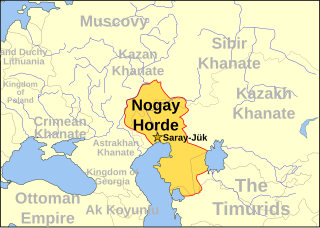
The Nogai Horde was a confederation founded by the Nogais that occupied the Pontic–Caspian steppe from about 1500 until they were pushed west by the Kalmyks and south by the Russians in the 17th century. The Mongol tribe called the Manghuds constituted a core of the Nogai Horde.

After it was established on most of the territory of the Russian Empire, the Soviet Union remained the world's largest country until it collapsed in 1991. It covered a large part of Eastern Europe while also spanning the entirety of the Caucasus, Central Asia, and Northern Asia. During this time, Islam was the country's second-largest religion; 90% of Muslims in the Soviet Union were adherents of Sunni Islam, with only around 10% adhering to Shia Islam. Excluding the Azerbaijan SSR, which had a Shia-majority population, all of the Muslim-majority Union Republics had Sunni-majority populations. In total, six Union Republics had Muslim-majority populations: the Azerbaijan SSR, the Kazakh SSR, the Kyrgyz SSR, the Tajik SSR, the Turkmen SSR, and the Uzbek SSR. There was also a large Muslim population across Volga–Ural and in the northern Caucasian regions of the Russian SFSR. Across Siberia, Muslims accounted for a significant proportion of the population, predominantly through the presence of Tatars. Many autonomous republics like the Karakalpak ASSR, the Chechen-Ingush ASSR, the Bashkir ASSR and others also had Muslim majorities.

The recorded history of the Crimean Peninsula, historically known as Tauris, Taurica, and the Tauric Chersonese, begins around the 5th century BCE when several Greek colonies were established along its coast, the most important of which was Chersonesos near modern day Sevastopol, with Scythians and Tauri in the hinterland to the north. The southern coast gradually consolidated into the Bosporan Kingdom which was annexed by Pontus and then became a client kingdom of Rome. The south coast remained Greek in culture for almost two thousand years including under Roman successor states, the Byzantine Empire (341–1204), the Empire of Trebizond (1204–1461), and the independent Principality of Theodoro. In the 13th century, some Crimean port cities were controlled by the Venetians and by the Genovese, but the interior was much less stable, enduring a long series of conquests and invasions. In the medieval period, it was partially conquered by Kievan Rus' whose prince Vladimir the Great was baptised at Sevastopol, which marked the beginning of the Christianization of Kievan Rus'. During the Mongol invasion of Europe, the north and centre of Crimea fell to the Mongol Golden Horde, and in the 1440s the Crimean Khanate formed out of the collapse of the horde but quite rapidly itself became subject to the Ottoman Empire, which also conquered the coastal areas which had kept independent of the Khanate. A major source of prosperity in these times was frequent raids into Russia for slaves.
As of January 2021, the estimated total population of the Republic of Crimea and Sevastopol was at 2,416,856. This is up from the 2001 Ukrainian Census figure, which was 2,376,000, and the local census conducted by Russia in December 2014, which found 2,248,400 people.

The Nogais are a Kipchak people who speak a Turkic language and live in the North Caucasus region. Most are found in Northern Dagestan and Stavropol Krai, as well as in Karachay-Cherkessia and Astrakhan Oblast; some also live in Chechnya, Dobruja, Turkey, Kazakhstan, Uzbekistan, Ukraine and a small Nogai diaspora is found in Jordan. They speak the Nogai language and are descendants of various Mongolic and Turkic tribes who formed the Nogai Horde. There are eight main groups of Nogais: the Ak Nogai, the Karagash, the Kuban-Nogai, the Kundraw-Nogai, the Qara-Nogai, the Utars, Bug-Nogai and the Yurt-Nogai.
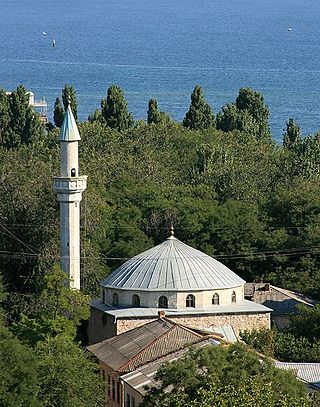
The Mufti-Jami Mosque, is located in Feodosiya, in Crimea.

The Kebir-Jami Mosque is located in Simferopol, Crimea. Kebir-Jami mosque is a prominent architectural monument in Simferopol and the oldest building in the city.
A muftiate is an administrative territorial entity, mainly in the post-Soviet and Southeast European states, under the supervision of a mufti. In the post-Yugoslavia states, spiritual administrations similar to the muftiate are called riyasat.

The Kokkoz Jami Mosque, also known as Yusupov's Mosque, is located in the village of Sokolyne (Kökköz), Crimea. In Crimean Tatar, kökköz translates to “falcon”, just like the Ukrainian and Russian names. The mosque was built under the patronage of Prince Felix Yusupov in 1910 by a notable contemporary architect Nikolay Krasnov, the author of the imperial residence Livadia Palace.
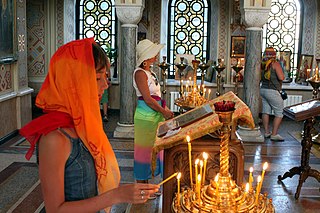
The majority of the Crimean population adheres to the Russian Orthodox Church, with the Crimean Tatars forming a Sunni Muslim minority, besides smaller Roman Catholic, Ukrainian Greek Catholic, Armenian Apostolic and Jewish minorities.
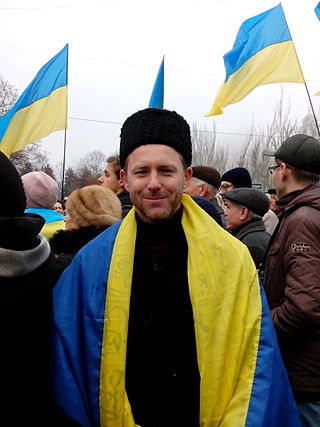
Sheikh Said Ismagilov - Mufti of the Religious Administration of Muslims of Ukraine “Ummah”, one of Muslim spiritual leaders of Ukraine, President of All-Ukrainian Public Organization “Ukrainian Center for Islamic Studies”, the Head of Muslim Community “Nur” of Donetsk city, the member of Public Organization “Al-Amal” of Donetsk city. Ukrainian scientist majoring in Islamic studies, the member of Donetsk regional cell of Ukrainian Association of Religion Researchers (UARR), the member of a board of directors of Center for Religious Studies and International Spiritual Relationships, the member of Council of Churches and Religious Organizations of Donetsk Region, lecturer of theology and religion in Ukrainian Islamic Institute (2001-2002), prominent public figure.

Aqmescit Friday Mosque, also known as the Great Friday Mosque and the Simferopol Cathedral Mosque named after Noman Çelebicihan is the largest mosque in Aqmescit (Simferopol), Crimea, which had been under construction since 2015 after Russian annexation of the Crimean peninsula. It opened on 9 December 2023.


